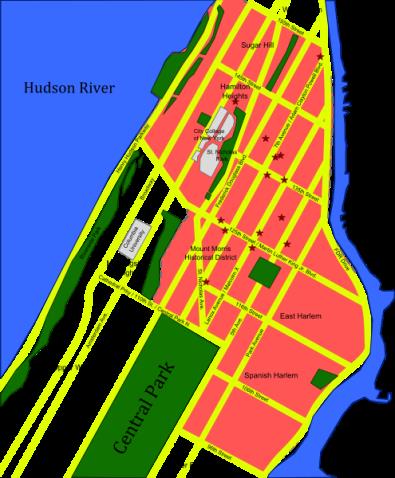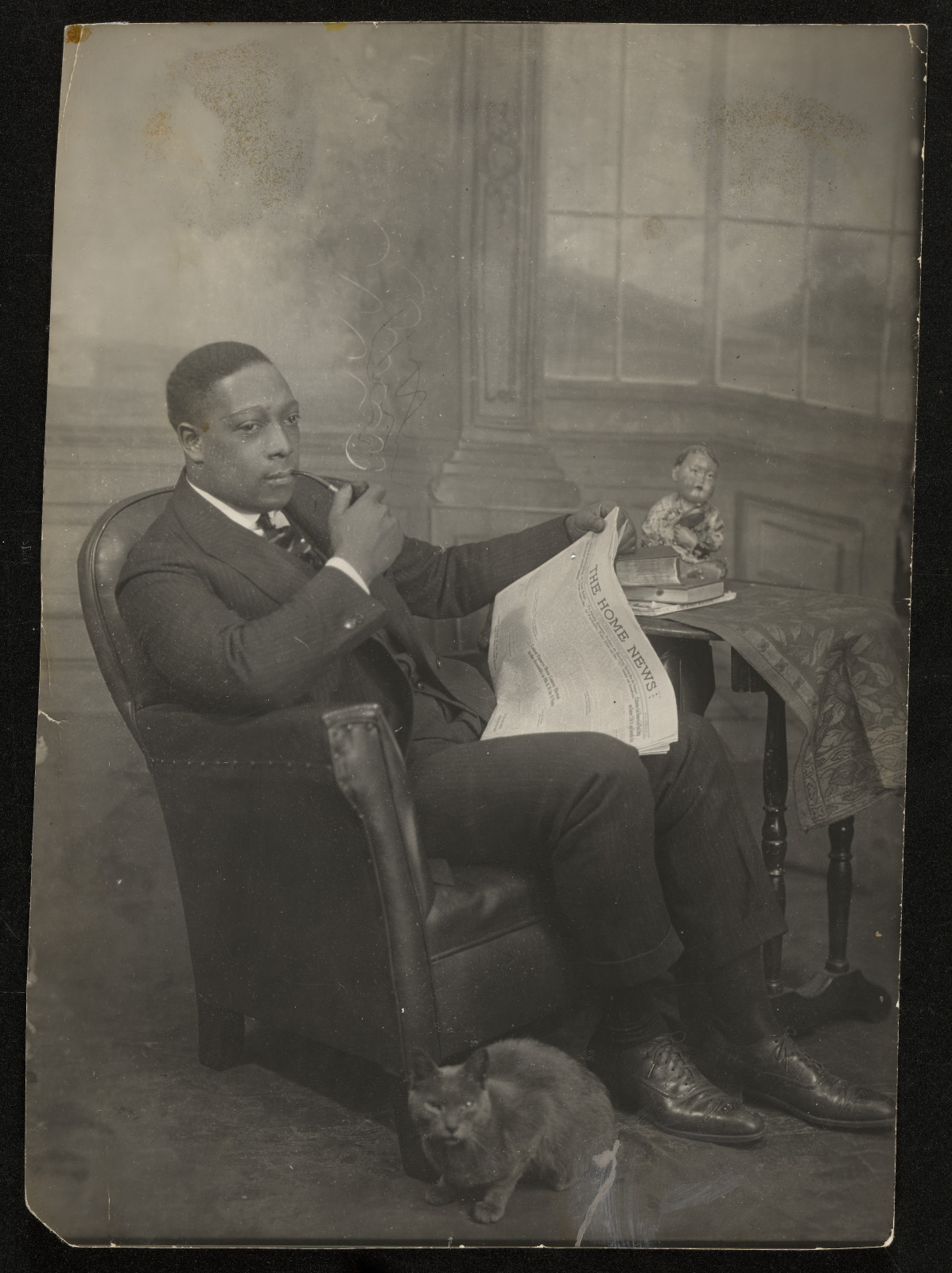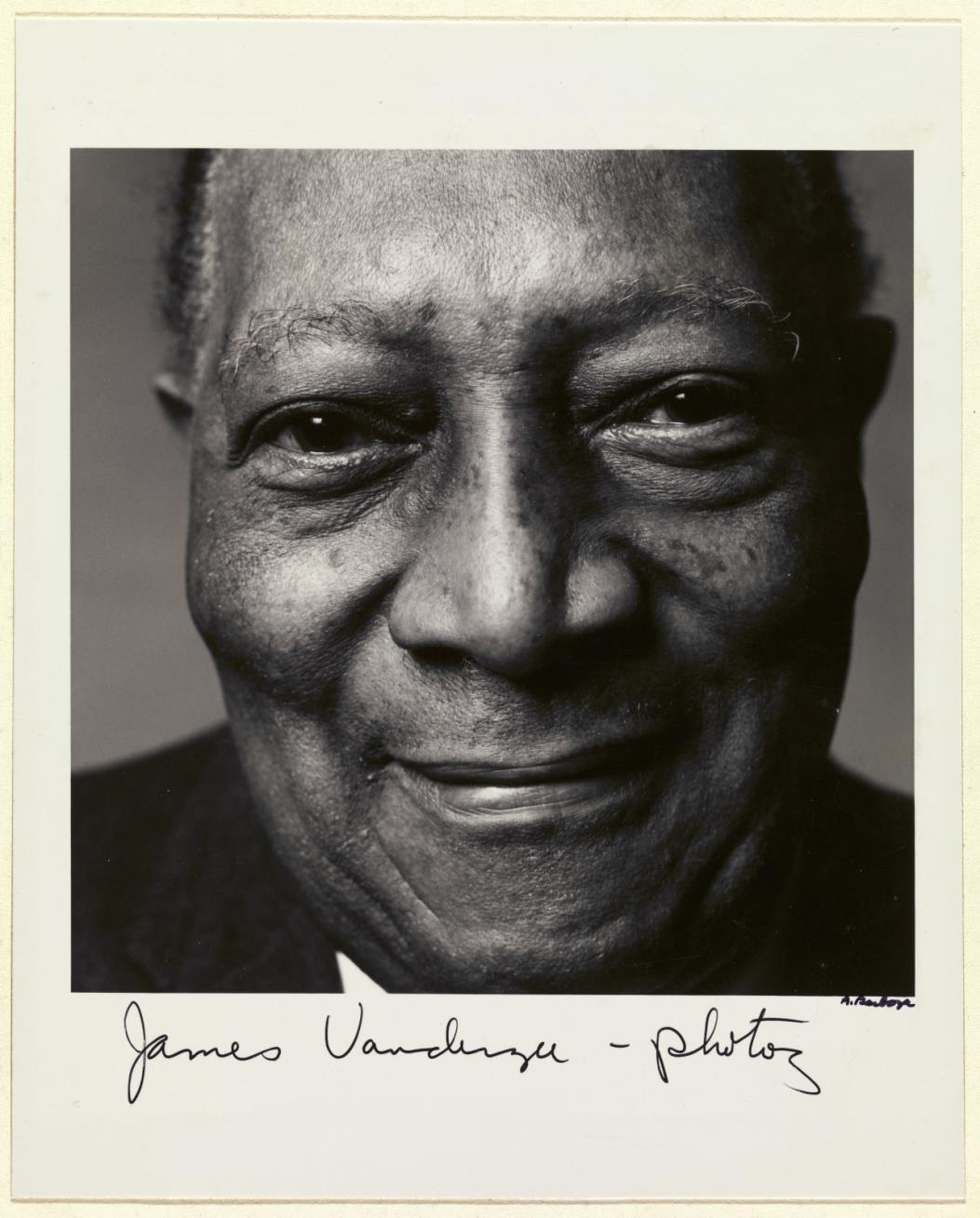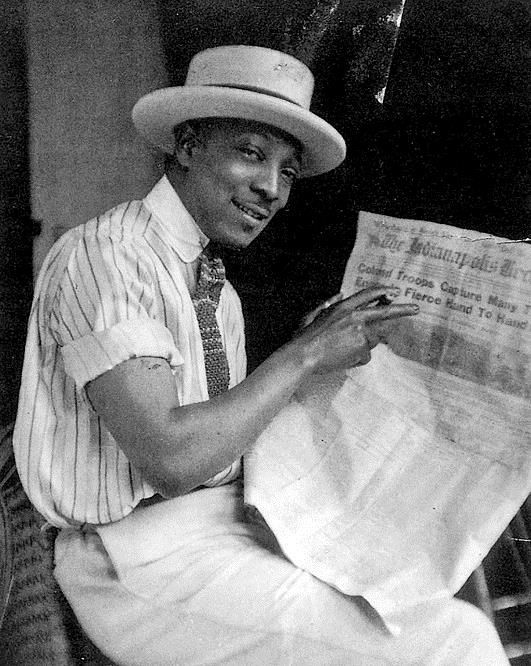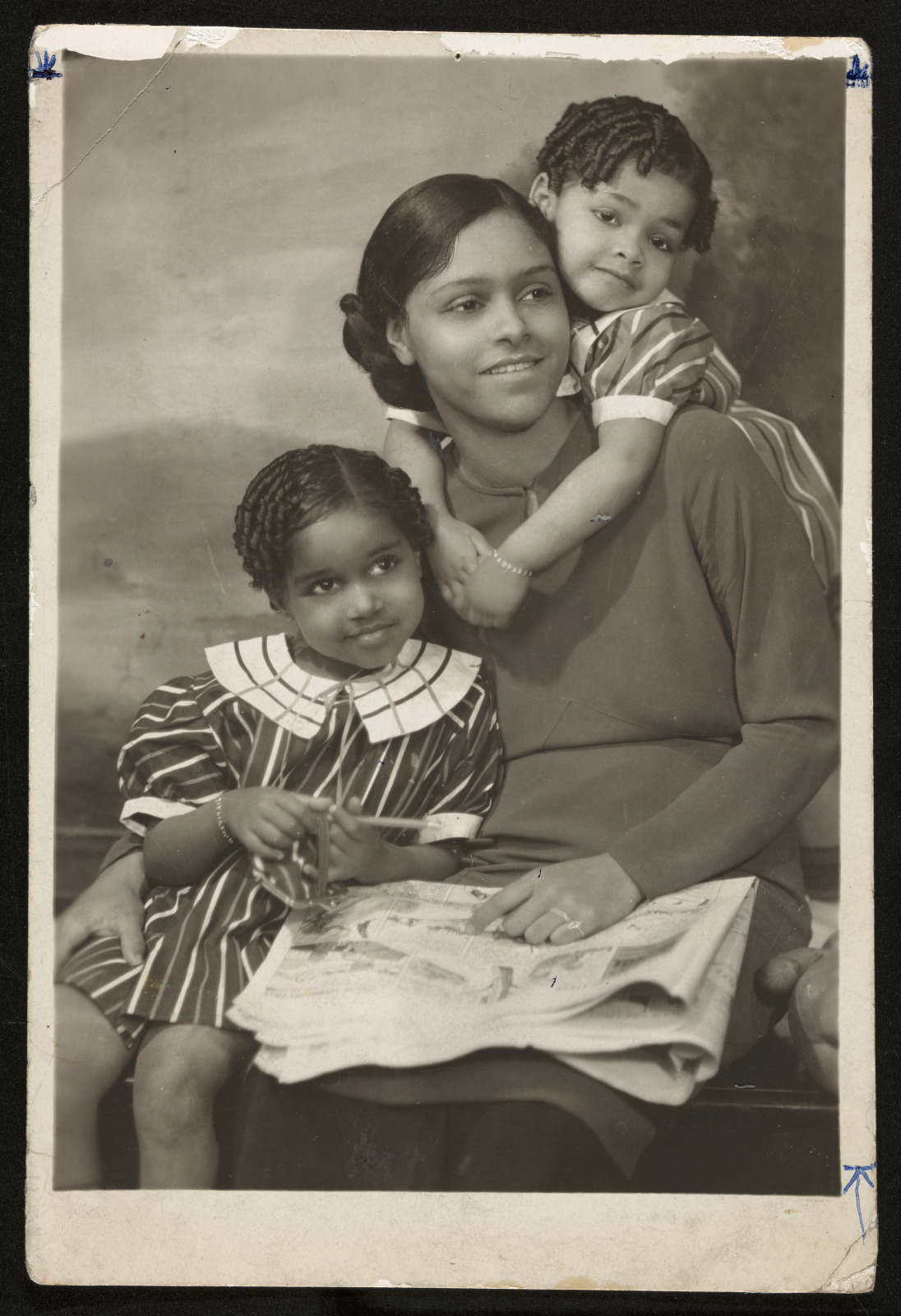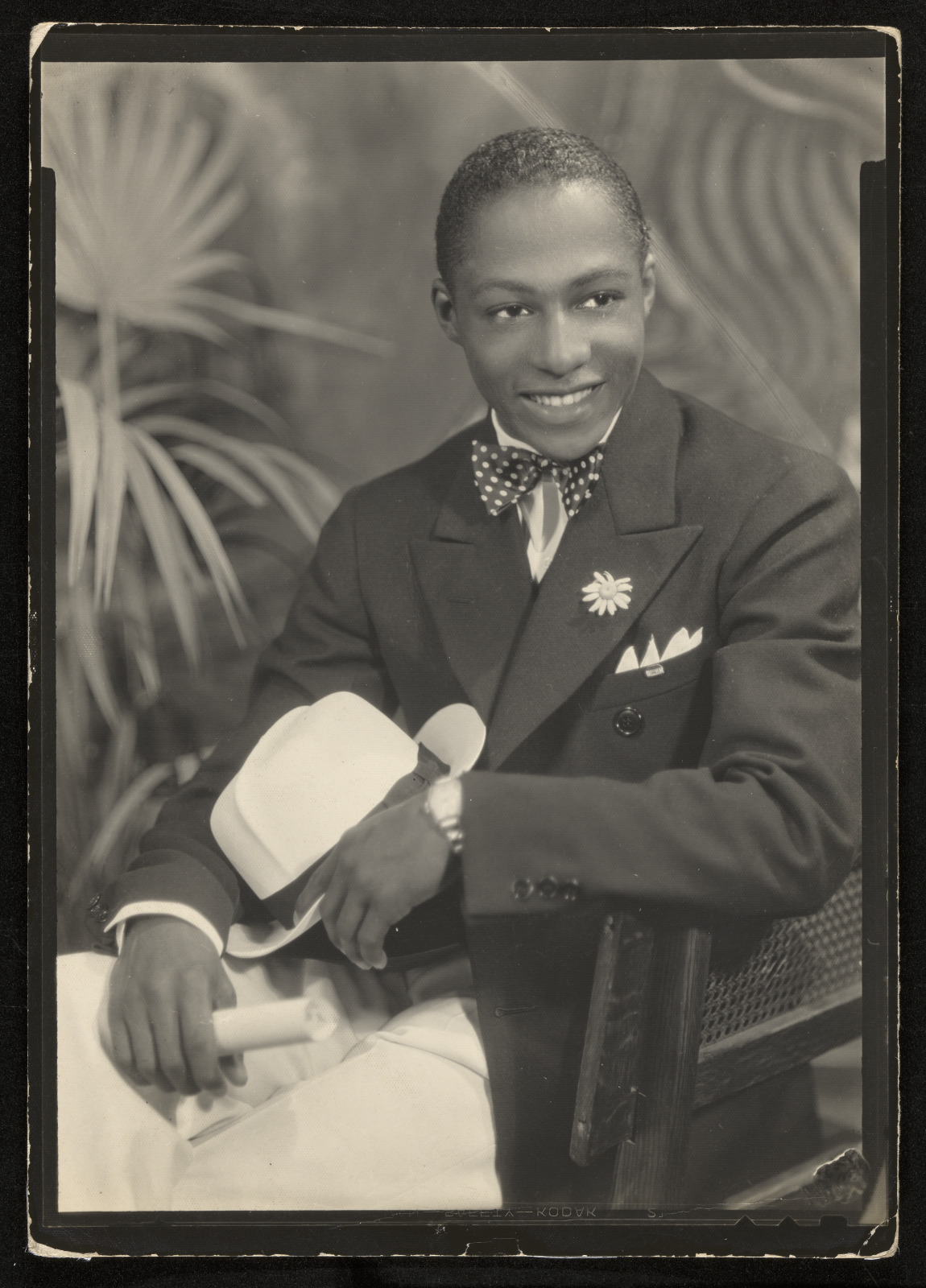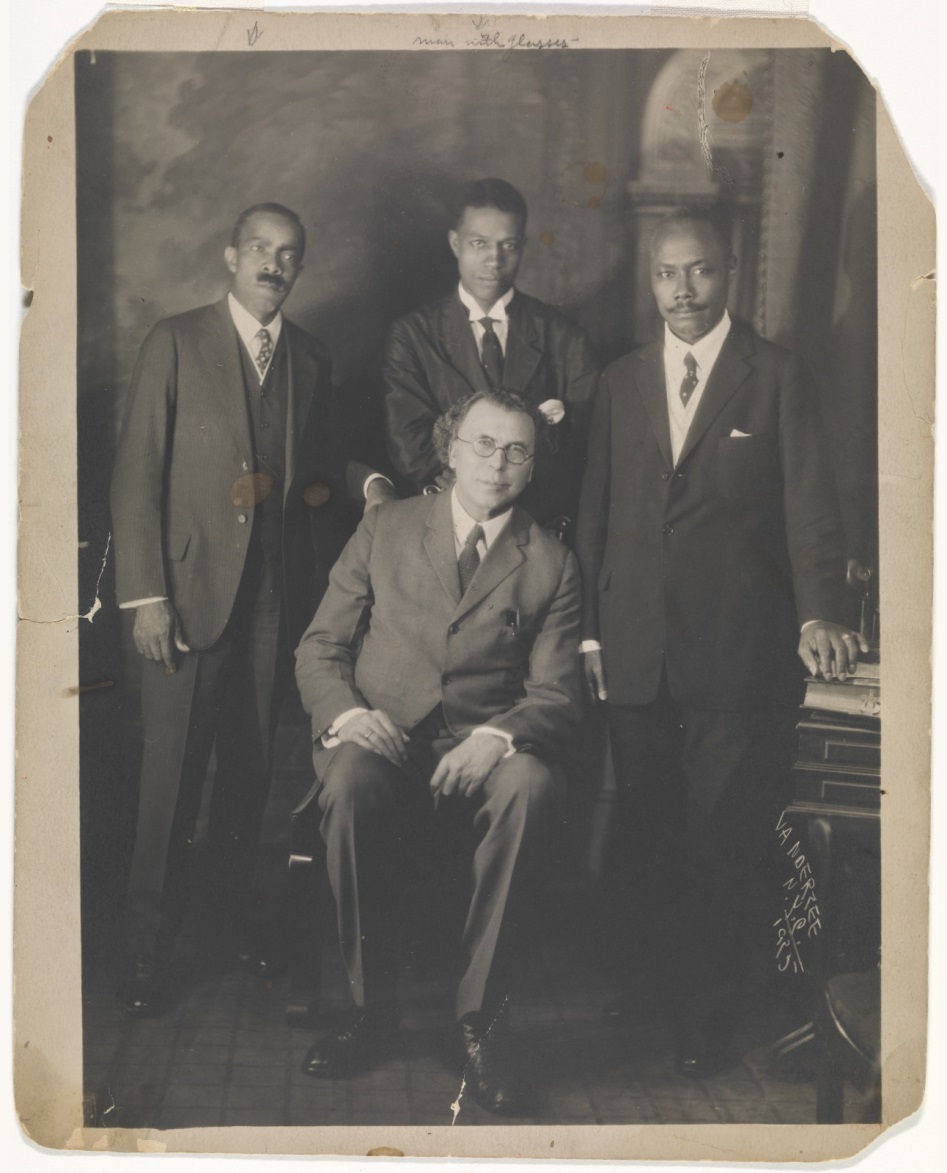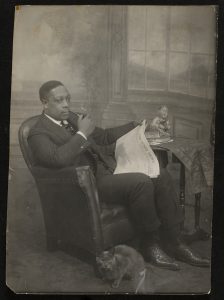
Picturing the Harlem Renaissance with James VanDerZee
Discover the Harlem Renaissance through James VanDerZee's photographs!
Introduction
In the 1920s and 30s, the phenomenon known as the Harlem Renaissance brought together a community of African American artists, writers, musicians, athletes, and religious leaders in the Harlem neighborhood of New York City. The cultural ferment that grew out of their actions and interactions produced expressive new art forms—and spread social and political ideas. Their achievements changed how African Americans were perceived throughout the world, and gave them a new sense of pride and a growing commitment to political activism.
James VanDerZee was Harlem’s preeminent photographer during this stimulating time. In the following activities, close observation of his photographs provide opportunities to learn about this fascinating era.
Note for Teachers
Goals for this Resource:
- To help students understand how to effectively use period photographs as primary sources;
- To review how the Great Migration and World War I affected the lives of African Americans in the United States;
- To highlight several aspects of the African American experience during the Harlem Renaissance—especially those that are often overlooked such as sports and public education; and
- To encourage students to examine the images they see using their creative and critical thinking skills.
You may choose specific sections of these active-looking experiences to set up or conclude lessons that relate to the Harlem Renaissance—or to enhance a more in-depth lesson on a specific topic. The answers that students type into the clickable “lessons” featured below can be downloaded and saved as Word documents, which can then be shared with the class or with you. (Use the “Jump to” menu to go directly to a particular section.)
Are you looking for projects? Many of the sections include suggestions for related research topics so that small groups or individual students can present investigate and present additional information.
The Harlem Renaissance: In Search of Opportunity and Identity
Setting the Stage
The Great Migration, which began around 1890 and continued into the 1970s, drew millions of Southern African Americans to northern cities. Life in the North was far from perfect, but there were more possibilities for better economic and social conditions there than African Americans experienced in the segregated South. As they formed new communities in Northern cities, black artists, writers, musicians, athletes, and religious leaders began to redefine what it meant to be African American. A new sense of pride and a commitment to political activism grew out of their creations and actions.
New York City’s Harlem neighborhood became the most famous of these communities, attracting many of the greatest talents of the era. This resource invites you to learn about this era through primary-source photographs taken during what has become known as the “Harlem Renaissance.”
Two Big Questions to Consider
Think about these two questions as you examine the photographs featured below that capture some of the faces and events of the Harlem Renaissance:
- How do the images we see shape our impressions of people and communities?
- What can we learn about people and communities of the past by examining photographs and
other works of art?
Unpack what you see in the photograph featured in the slide set below. Click through the slides and answer the prompts. If you are part of a class, you may want to form small groups, with each group discussing one set of questions. You will be able to download your work when you reach the final slide.
Who was James VanDerZee?
The distinguished African American photographer James VanDerZee (1886–1983) took this self-portrait in 1925—and he purposely arranged every aspect of the scene to convey meaning. He posed in his studio in front of a painted set and carefully placed the furniture, props, and the cat at his feet. He even added the soft curls of smoke from his pipe to the photographic negative before printing the photograph.
VanDerZee was the most successful photographer in Harlem during the renewal and flourishing of African American culture that took place in the 1920s and early 30s. Best known today as the Harlem Renaissance, this cultural explosion was originally called the New Negro Movement—and similar artistic and social developments took place in other large Northern cities, including Washington DC, Chicago, and Boston.
How would you set the scene for your self-portrait?
Learn More!
Let’s learn more about this prolific photographer and explore a few of his photographs of the people of Harlem.
Many of the African American artists, writers, musicians, and other leaders of this era dedicated considerable time and effort into mentoring and nurturing younger generations. VanDerZee, for exapmple, helped to pave the way for future African American photographers, particularly the collective known as Kamoinge, which was founded in 1963. The photo at left was taken by Anthony Barboza, one of the younger members of that group.
Discover more in this story: Working Together: Louis Draper and the Kamoinge Workshop.
VanDerZee’s Lens Captures a New Generation
VanDerZee began taking photographs while still a teenager in his hometown of Lenox, Massachusetts. While in his 20s, he tried his hand at a number of different jobs and lived in several different locations, including New York City and Phoenix, Virginia.
He returned to New York City in 1908 and worked intermittently as a musician and music teacher. In 1915, he moved to New Jersey where he landed his first professional job in photography as a darkroom assistant and occasional portrait photographer.
By 1916, he was ready to start his own business. Moving to Harlem, he opened the Guarantee Photo Studio, which catered to the local African American community. When the U.S. entered World War I in April 1917, demand for his services increased significantly. Parents wanted photographs of their enlisted sons headed overseas—and sons wanted photographs of loved ones to take with them.
African Americans and World War I
Notice the headline on the newspaper?
We can’t see all the words, but we can read:
“Colored Troops Capture Many ________
___________ Fierce Hand to Hand_______”
- What do you think this headline is about?
- What do you think the missing words might be?
- How is this portrait different from the one taken in 1925?
- If a similar headline appeared today, how would it differ from one written in 1918?
The U.S. National Archives record that more than 380,000 African-Americans served in the U.S. Army during World War I. Most of them were assigned support tasks, but the 369th Infantry Regiment, known as the “Harlem Hellfighters,” fought with French combat forces. The regiment was awarded the Croix de Guerre, the highest French military honor and its soldiers received 171 individual decorations for heroism.
Taking It Further:
Looking for research projects? Try one of these topics and share your findings with your class:
- The Red Summer of 1919: Be sure to consider how the experiences of African American servicemen in Europe during WWI affected their expectations as they came home to the United States? Also note: Many young men across the United States joined the armed services during WWI, while immigration to the U.S. declined. The resulting labor shortages provided new job opportunities for African American workers. What effect did this situation have as servicemen returned to civilian life?
- If We Must Die, a poem by Charles McKay, written in response to the Red Summer of 1919: Although McKay first published If We Must Die in the July 1919 issue of The Liberator, his sonnet doesn’t directly reference the events of the summer. Do you think it can be understood as a universal statement? How could you connect it with other places and times?
James VanDerZee and the “New Negro”
The term “New Negro” appeared in numerous publications and contexts beginning as early as the 1890s, including Alain Locke’s influential anthology titled The New Negro: An Interpretation, published in 1925. The term called for new images and associations that would contrast sharply with the denigrating stereotypes that appeared in contexts such as minstrel shows and “Lost Cause” fiction and art.
You can examine many of these disturbing images and objects online at The National Museum of African American History and Culture: Popular and Pervasive Stereotypes of African Americans.
This site also provides the following statement about the image: “Objects depicting racist and/or stereotypical imagery or language may be offensive and disturbing, but the NMAAHC aims to include them in the Collection to present and preserve the historical context in which they were created and used. Objects of this type provide an important historical record from which to study and evaluate racism.”
Discussion Prompts:
- Why were new images so important?
- Look back over your response to the big question:
- How do the images we see shape our impressions of people and communities?
When VanDerZee established his photographic Studio in 1916, a half century had passed since the end of the Civil War. The number of African Americans in the middle and upper classes had increased dramatically, especially as the Great Migration drew thousands of them to northern cities. The new generations of doctors, lawyers, publishers, writers, musicians, and business owners wanted to document their success and the significant events of their lives with photographs—and VanDerZee’s artistic process produced exactly the kind of photographs his clients desired. He was adept at arranging scenes and retouching negatives to achieve the perfect effect. He commented, “I tried to see that every picture was better-looking than the person.”
- How would you describe the mother and daughters in this photograph?
- How would your impression change if the mother did not have a newspaper in her lap?
Taking It Further:
Looking for research projects? Try one of these topics and share your findings with your class:
- The New Negro; An Interpretation, an anthology of fiction, poetry, and essays on African and African-American art and literature edited by Alain Locke and published in 1925.
- “American Negro” exhibit at the 1900 Paris Exposition assembled by W.E.B DuBois and Daniel Murray
Education and the Harlem Renaissance
Let’s look at a VanDerZee photograph of a young man. Spend a few minutes examining this photograph. Make a list of the things you notice. What title would you give this photograph?
Think back to the big question: What can we learn about people and communities of the past by examining photographs and other works of art?
This photograph is titled “The Graduate.”
- How does this title affect how you see this young man?
- Does it tell you anything about what might have been important to him and his family? Explain your answer.
Educational Opportunities in Harlem ca. 1935
Although educational opportunities were better in northern cities than in many parts of the South, conditions in public schools in Harlem were deplorable. The following description of the state of education in Harlem in the 1930s was written by Richard Wright and Charles McKay in an essay for New York Panorama (page 132), a book published in 1938 as part of the Federal Writer’s Project: Portrait of Harlem (page 132).
“The community’s facilities for public education are woefully inadequate. Although the population of Harlem has more than tripled since the World War [WWI], not one new school building was constructed in this region during the post-war period until 1937. Many of the buildings are antiquated fire-traps, without playgrounds or auditoriums. In one school, lunch is served to 1,000 children in a room designed to seat only 175. There are no specialized or nursery schools, and because of discriminatory zoning Negro students are not permitted to attend newer and better-equipped schools in adjacent areas.”
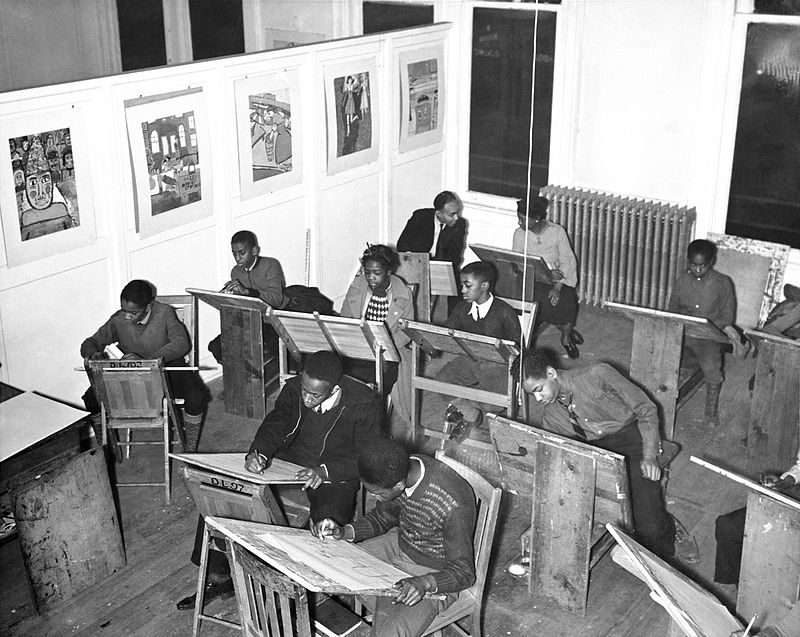
Students in a free art class at the Harlem Community Art Center, 290 Lenox Avenue, New York City. The class was sponsored by the Federal Art Project. By Works Progress Administration, Federal Art Project; David Robbins, photographer - Archives of American Art, Public Domain
Harlem Artists and Writers Take Action!
Harlem Art Center:
Many of the African American writers and artists who were active during this era in Harlem worked to provide better opportunities for the people in their communities. Wright notes that by 1937, fifteen art centers offering instruction in painting, ceramics, carving, and sculpture had been established in area churches, YWCAs, YMCAs, and neighborhood houses. One of the most famous was the Harlem Art Center, first directed by the influential artist and teacher Augusta Savage and later by artist and writer Gwendolyn Bennett. Image: Harlem Art Center Class
Negro History Club and Young People’s Forum:
Another example of community action was the formation of the Negro History Club, founded in 1928 by Ella Baker. Held at the 135th Street Library, this club provided adults with a venue for discussing historical and contemporary issues. In the 1930s, Baker also organized the Young People’s Forum to offer similar opportunities for teens and young adults.
New Publications and Means of Distribution:
During this time frame, the intellectual vibrancy of the Harlem Renaissance inspired many African American writers and thinkers to make their voices heard through poetry, novels, plays, essays, and articles. These works were published in magazines, journals, and newspapers including:
- The Crisis – the official magazine of the National Association for the Advancement of Colored People (NAACP), founded in 1910, and edited by W.E.B. DuBois;
- Opportunity: A Journal of Negro Life – the official magazine of the National Urban League which began to circulate in 1923; and
- The Messenger – a journal edited by A. Philip Randolph and Chandler Owen, which was published from 1917 to 1928.
Ultimately these publications and the audiences they drew made it much easier for African American writers to find mainstream publishers for their work—and as these works proliferated, public libraries also provided increased access to the books, articles, and newspapers. Library branches and art center also began to offer exhibitions of works of art by African Americans.
Taking It Further:
Looking for research projects? Try one of these topics and share your findings with your class:
- The Crisis magazine
- Arthur Schomburg and the 135th Street branch of the New York Public Library
Music and the Harlem Renaissance
Music was an important aspect of the Harlem Renaissance. Performers and musicians, including Fats Waller, Duke Ellington, Bessie Smith, and Billie “Lady Day” Holiday, made jazz popular not only in Harlem, but throughout the country.
Take a close look at the photograph below.
- What do you notice about this photograph?
- What does it tell you about the community?
- How can music affect how we see the world around us?
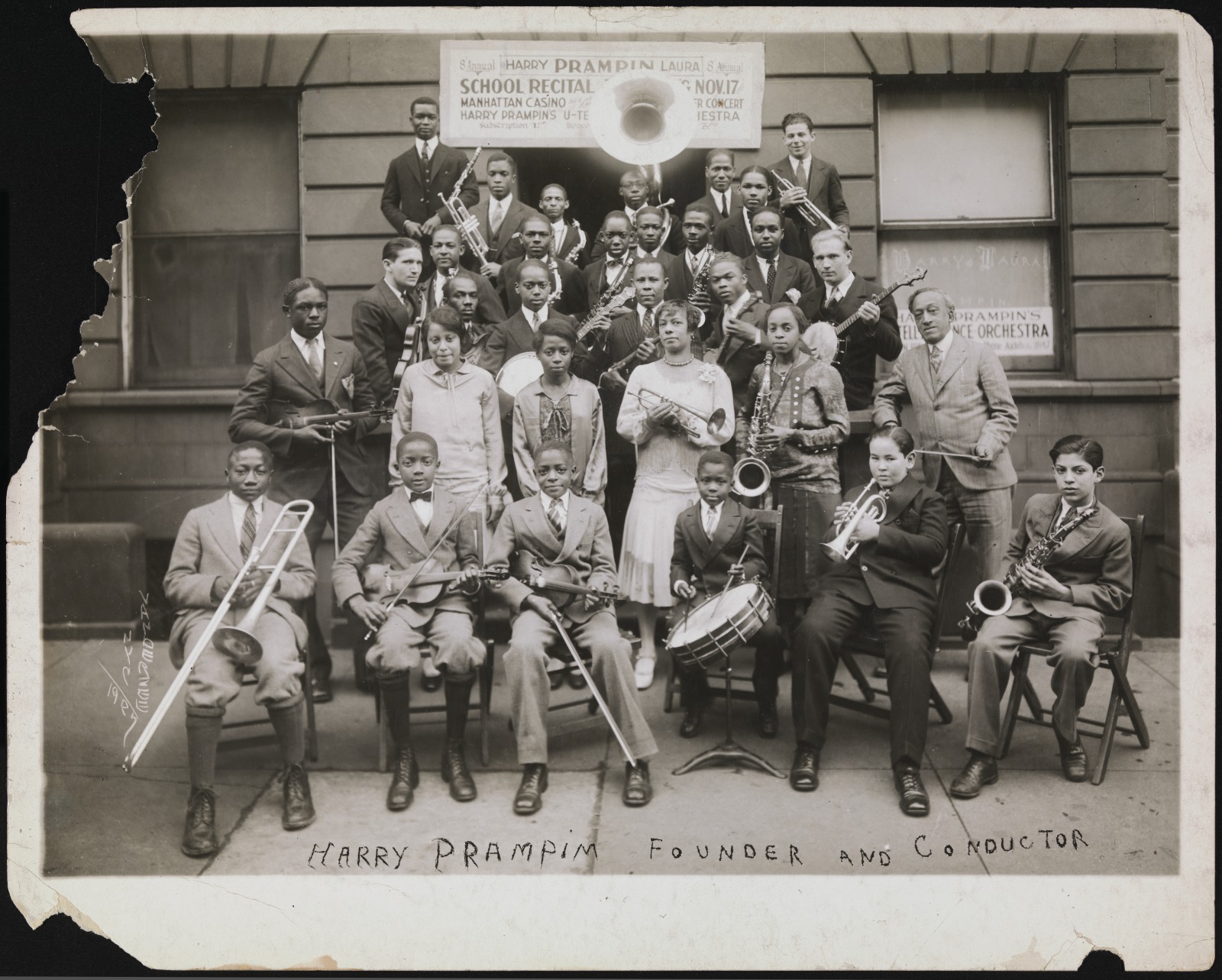
Harry Prampin School Recital, 1927, James VanDerZee (American, 1886–1983), gelatin silver print. Virginia Museum of Fine Arts, National Endowment for the Arts Fund for American Art, 2001.18
This photo was taken in 1927. It was acquired by VMFA in 2001, but when and where the print was torn is unknown. Many of VanDerZee’s photographs were organized and documented by his third wife, Donna Mussenden VanDerZee, but this one bears only “G.G.G. Photo Studio, Inc./ 109 West 135th St” stamped twice in blue ink on the back of the photo.
Learn More About Jazz!
Watch for the photograph Harry Prampin School Recital to appear in the video titled The Pull to Harlem, which is excerpted for the classroom from the Ken Burns PBS series on jazz. How has it been cropped for the video?
Although the complete PBS Ken Burn’s series on jazz requires a membership, the site offers a number of video excerpts and free resources, including A Basic Primer to Key Musical Concepts.
Taking It Further:
Looking for research projects? Try one of these topics and share your findings with your class:
- Duke Ellington
- Louis Armstrong
- King Joe (Joe Louis Blues): music by Count Basie, lyrics by Richard Wright, recorded by Paul Robeson.
Click on the hotspots on the images to learn more about these people.
Baseball and the Negro National League
Although the Harlem Renaissance is mainly associated with artistic and literary developments, the energy it generated also influenced sports—and many athletes helped to change the way African Americans were perceived.
VanDerZee’s work includes many sports-related photographs, including athletic club groups, prominent boxers, and basketball teams. In this photograph, he takes us out to the ballpark for a game of baseball.
Look carefully at the photograph below as you consider these questions:
- As you look closely, what questions come to mind?
- Where do you think this game is being played?
- What do you notice about the fans in the stands?
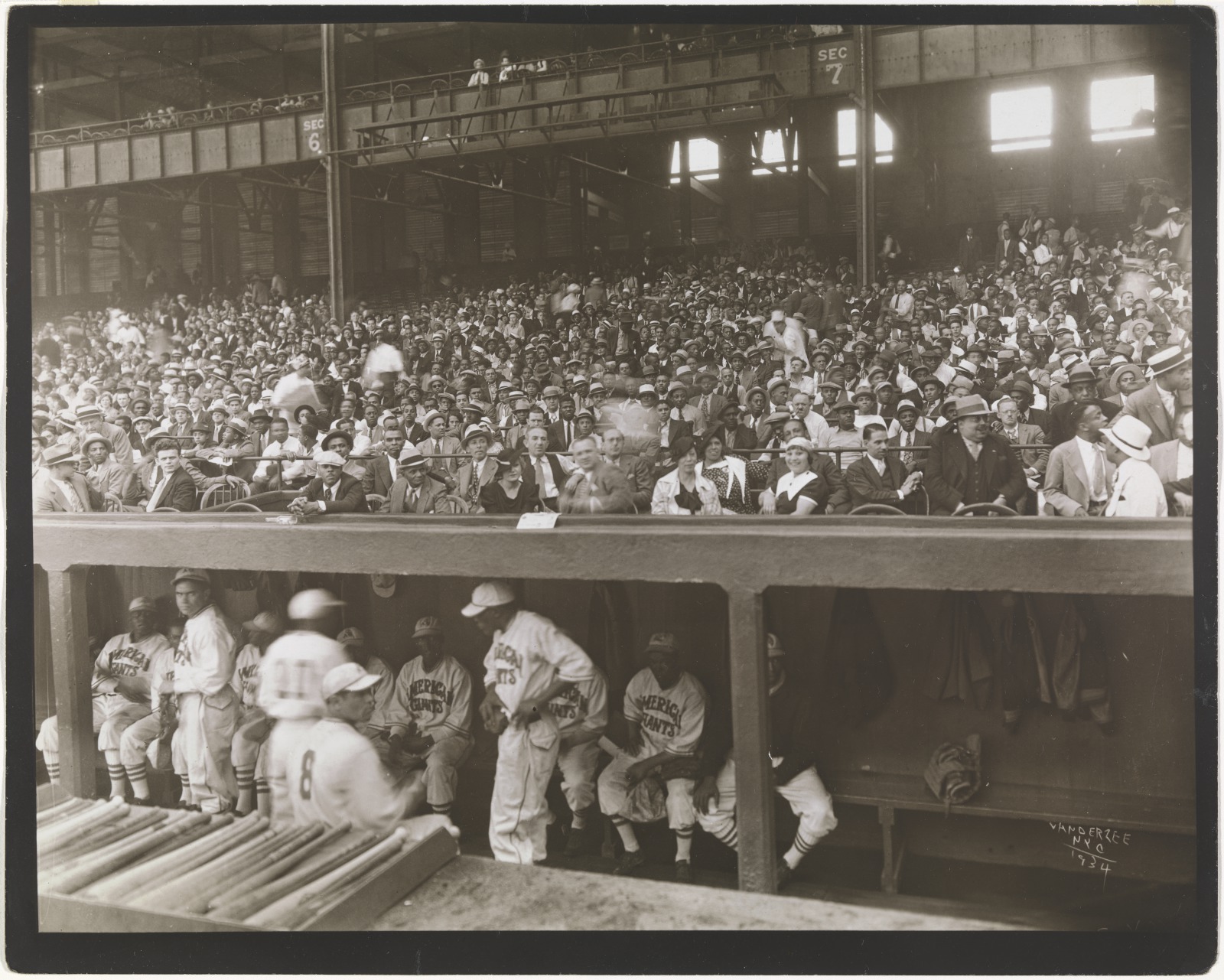
American Giants Dugout, 1934, James VanDerZee (American, 1886–1983), gelatin silver print. Virginia Museum of Fine Arts, National Endowment for the Arts Fund for American Art, 2001.20
The Harlem Renaissance and Black Churches
The Harlem Renaissance era led to new conceptions of African American identity and culture—and black churches were a significant part of the African American experience. Religious references and themes abound in the poems, novels, and plays written during this timeframe, and many religious leaders played significant roles in the progressive politics of the era. Churches also provided meeting places for discussions, poetry readings, art exhibitions, and community outreach.
The religious life of Harlem was the subject of many of VanDerZee’s photographs. He photographed weddings, funerals, church groups, and other church-based events. In this group portrait, taken in 1925, he photographed the influential pastor Adam Clayton Powell, Sr. with the Reverends Bolen, Brown, and Cullen.
Who are these men? Seated at the front is Adam Clayton Powell, Sr., an African American pastor and civil rights activist. His leadership helped to transform Harlem’s Abyssinian Baptist Church into the largest congregation in the United States. He also played noteworthy roles in the NAACP and the National Urban League. His son Adam Clayton Powell, Jr., followed his father as pastor of the church—and became the first black Congressman from New York City, serving in the House of Representatives from 1945 until 1971.
Standing at left is Reverend Frederick Asbury Cullen, pastor of the Salem Methodist Episcopal Church in Harlem. He served as president of the Harlem chapter of the NAACP and helped to found the National Urban League—and was one of the chief organizers of the Negro Silent Protest Parade in 1917. His adopted son was the acclaimed poet Countee Cullen.
Researchers have not verified the identities of the other two reverends, although Brown may be Edgar Egbert Ethelred Brown, a Jamaican Unitarian minister who founded Harlem’s Community Church in 1920.
Taking It Further:
Looking for research projects? Try one of these topics and share your findings with your class:
- Countee Cullen
- Mother African Methodist Episcopal Zion Church
- Abyssinian Baptist Church
- God’s Trombones: Seven Negro Sermons in Verse by James Weldon Johnson with illustrations by Aaron Douglas
James VanDerZee’s Legacy: Patience and Persistence
In the latter part of the 1930s, VanDerZee struggled to make ends meet as money became tight during the Great Depression–and personal cameras became easily accessible. For the next several decades, he managed to stay solvent by taking passport photos, calendar pictures, and photograph restoration.
In 1969, researchers “rediscovered” VanDerZee. The Metropolitan Museum of Fine Art featured an exhibition called Harlem on My Mind, which relied largely on images from his archive. The exhibition itself sparked a number of protests because it did not include any paintings or sculptures by African Americans and had not sufficiently included input from the Harlem community. It did, however, focus worldwide attention on VanDerZee’s body of work.
In 1979, he received the International Black Photographers Award and the Living Legacy Award. In his later years, he also became a mentor to a group of New York-based African American photographers who published The Black Photographers Annual from 1973 to 1980. This group sponsored annual dinners to recognize the black photographers who blazed the trail for their work. In 1979, the first of these dinners honored Roy DeCarava and James VanDerZee.
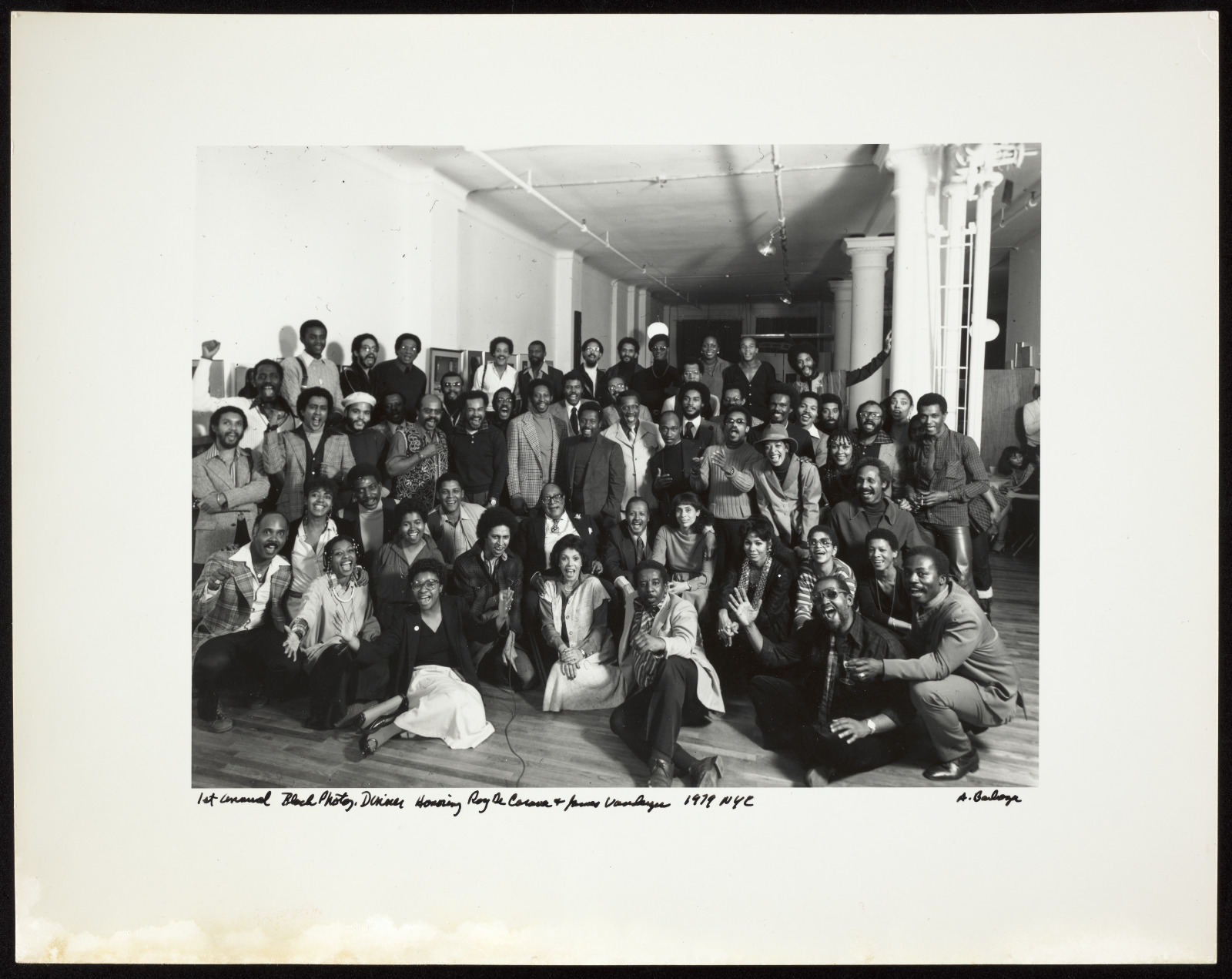
1st Annual Black Photographers Dinner Honoring Roy DeCarava & James Vanderzee, NYC, 1979, Anthony Barboza (American, born 1944), gelatin silver print. Virginia Museum of Fine Arts, Arthur and Margaret Glasgow Endowment, 2017.38
In an interview for the Volume Four of the Black Photographers Annual, VanDerZee was asked for his advice to young photographers. He replied in just three words,
“Patience and Perseverance.”
CONCLUDING THOUGHTS
The hardships of the Great Depression affected African Americans disproportionately. As economic conditions worsened, the initial energy of the era was dampened—although many artists and writers found work through the Works Progress Association.
Their legacy, however, continues today! The seeds planted by Harlem Renaissance artists, writers, musicians, and leaders have inspired countless new creations by the generations of people who followed in their footsteps. Finish this exploration by recording your final thoughts about a selection of photographs by James VanDerZee as you click through the slides below. What do they lead you to think about? What questions do you have now?
Selected Sources
The New Negro and the Black Image: From Booker T. Washington to Alain Locke
Henry Louis Gates, Jr.
Harvard University, National Humanities Center Fellow, ©National Humanities Center
The Long-Lasting Legacy of the Great Migration, By Isabel Wilkerson,
Smithsonian Magazine, SEPTEMBER 2016
U.S. Department of Defense article: African-American Troops Fought to Fight in World War I
NYT article on American Giants: BLACK YANKEES LOSE, 4-3, BEFORE 20,000
National Baseball Hall of Fame: THE NEGRO NATIONAL LEAGUE IS FOUNDED
